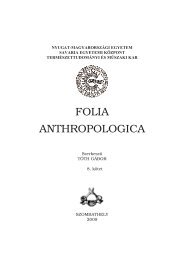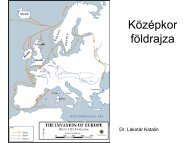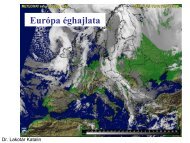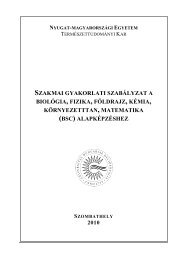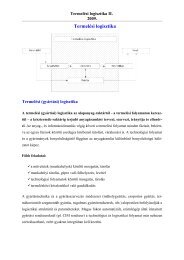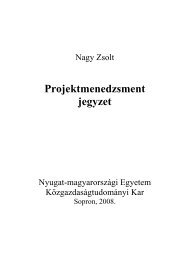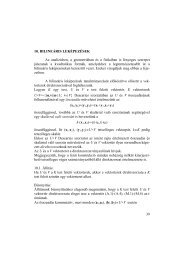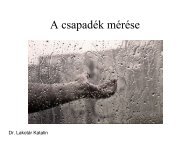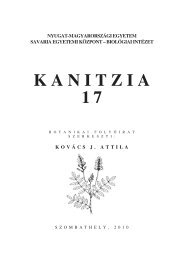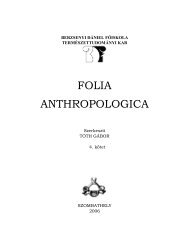folia11 - NYME Természettudományi Kar - Nyugat-magyarországi ...
folia11 - NYME Természettudományi Kar - Nyugat-magyarországi ...
folia11 - NYME Természettudományi Kar - Nyugat-magyarországi ...
You also want an ePaper? Increase the reach of your titles
YUMPU automatically turns print PDFs into web optimized ePapers that Google loves.
steatopygiásokétól, amiből arra következtetek, hogy valószínűleg nem az őskőkori (zsírfarú<br />
népesség) tovább éléséről van szó, hanem a kurtalábú, viszonylag hosszú törzsű (steatopygiás) népesség<br />
később került a Kárpát-medencébe és a történelmi korokra „eltűnt”. Mai szemmel nézve nem<br />
lehettek arányos testűek, egyes részeik harmóniája jócskán eltért a mai és paleolitikus populációtól.<br />
MARLOWE és mtsai (2005) úgy nyilatkoztak, hogy a szobrokon látható derék/csípő arány a<br />
(korabeli) férfiak preferenciáit jelzi. Kétségtelen, hogy a kortárs népességen végzett felmérések szerint<br />
is a keskeny derék és széles csípő a női attraktivítás legfontosabb elemei közé tartozik (FURHAM et<br />
al. 1997, 1998, MARLOWE et al. 2001, 2005, SINGH 1993, 1994). Lehetséges, hogy a neolitikus<br />
népességek (férfi) tagjai zsírfarú asszonyaikat tekintették szépnek, kívánatosnak. Minden esetre<br />
nemcsak az asszonyok habitusa, hanem a szépségideál is jócskán megváltozott a történeti korokra.<br />
Köszönetnyilvánítás: Ez úton is hálásan köszönöm Ilon Gábornak a kézirat átnézését, az ahhoz fűzött<br />
tanácsait, javaslatait.<br />
Irodalom<br />
BAILEY, D.W. (2005): Prehistoric Figurines: Representation and Corporeality in the Neolithic. London:<br />
Routledge.<br />
DUHARD, J. P. (1991): The shape of pleistocene women. Antiquity 65: 552–561.<br />
DUHARD, J. P. (1993): Etude comparatique des statuettes fèmines de Sireueil et Tursac (Dordonne). Gallia<br />
Prèhistoire 35: 283–291.<br />
DUHARD, J. P. (1994): L’identitè physiologique urèlèment d’interprètation des figurinations fèminines<br />
palèolithiques. Trabajos de Prehiostorie 51: 39–53.<br />
FURNHAM, A.–TAN, T.–MCMANUS C. (1997): Waist-to-hip ratio and preference for body shape: a<br />
replication and extension. Personality and Individual Differences 22: 539–549.<br />
FURNHAM, A.–DIAS M.–McCLELLAN D. (1998): The role of body weight, waist-to-hip ratio, and breast size<br />
in judgments of female attractiveness. Sex Roles 39: 311–26.<br />
HANSEN, S. ( 2007): Bilder vom Menschen der Steinzeit. Verl. Ph. Zabern, Mainz.<br />
HERMANUSSEN, M. (2003): Stature of early Europeans. Hormones 2: 175–178.<br />
HILLOOWALA, R. (2000): Anatomy and the art of archaic Greece. Anat. Record 261: 50–56.<br />
HUDSON, M. J.–AOYAMA, M. (2007a): Waist-to-hip ratios of Jomon figurines. Antiquity 81: 961–971.<br />
HUDSON, M. J.–AOYAMA, M.–KAWASHIMA, T.–GUNJI, T. (2007b): Possible steatopygia in prehistoric<br />
central Japan: evidence from clay figurines. In: J-STAGE (www.jstage.jst.go.jp) DOI: 10.1537/ase.060317.<br />
(Anthropological Science 2007).<br />
HUFSCHMIDT, H. J. (1977): Body proportion in sculpture and painting. An anthropometric and historical<br />
study. Arch. Psychiatr.Nervenkr. 224: 187–202.<br />
ILON G. (szerk.) (2007): Százszorszépek. Az emberábrázolás az őskori <strong>Nyugat</strong>-Dunántúlon. Szombathely.<br />
JÓZSA L. (2008): Az elhízás és ábrázolása az őskőkorban. Orvosi Hetilap 149: 2309–2314.<br />
JÓZSA, L. G. (2011): Obesity and steatopygia depicted on paleolithic statues. Praehistoria. Közlésre elfogadva.<br />
JÓZSA L. (2010): Milyen lehetett (volt?) az őskőkori asszony testalkata? Folia Anthrop. 9: 19–37.<br />
JÓZSA, L. G. (2011): Obesity in Paleolithic Era. Hormones 10: 242–245.<br />
KALICZ N. (2007): Az őskori agyagszobrászat kezdetei. In.: Ilon, G. (ed): Százszorszépek. Az emberábrázolás<br />
az őskori <strong>Nyugat</strong>-Dunántúlon. Szombathely. 13.<br />
KRUT, I. H.–SINGER, R. (1963): Steatopygia, The fatty acid composition of subcutaneous adipose tissue in the<br />
Hottentot. Am. J. Phys. Anthropol. 21: 181–187.<br />
MARINGER, J. (1974): Clay figurines of the Jomon period: a contribution to the history of ancient religion in<br />
Japan. History of Religions 14: 128–139.<br />
MARLOWE, F. W. (1998): The nubility hypothesis: the human breast as an honest signal of residual<br />
reproductive value. Human Nature 9: 263–271.<br />
MARLOWE, F.–WESTMAN, A. (2001): Preferred waist-to-hip ratio and ecology. Personality and Individual<br />
Differences 30: 481–489.<br />
MARLOWE, F.–APICELLA, C.– REED, D. (2005): Men’s preferences for women’s profile waist-to-hip ratio<br />
in two societies. Evolution and Human Behavior 26: 458–468.<br />
NEMESKÉRI, J. (1951): Anthropologische Untersuchung der Skelettfunde von Alsónémedi. Acta Arch. Hung.<br />
1: 55–72.<br />
38




